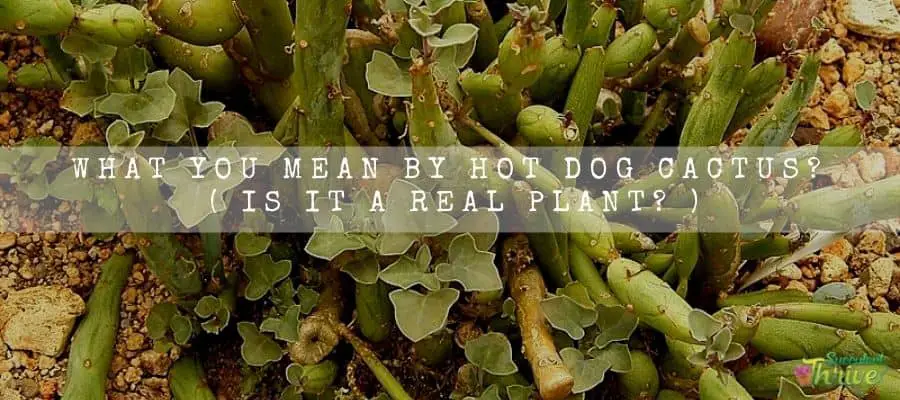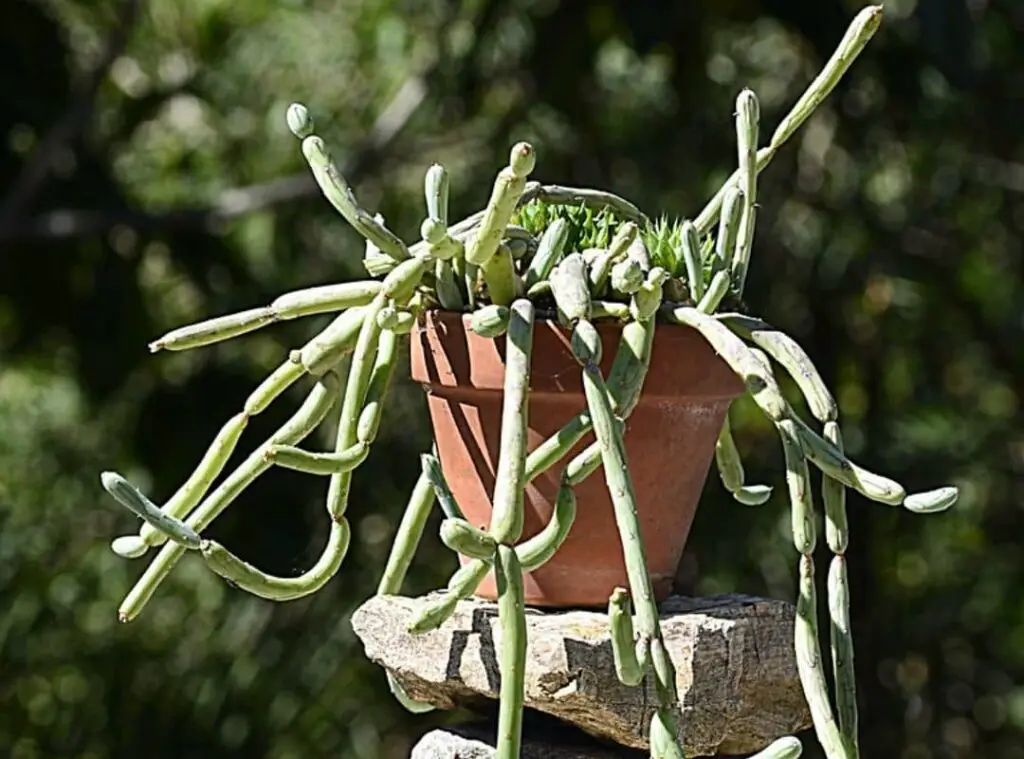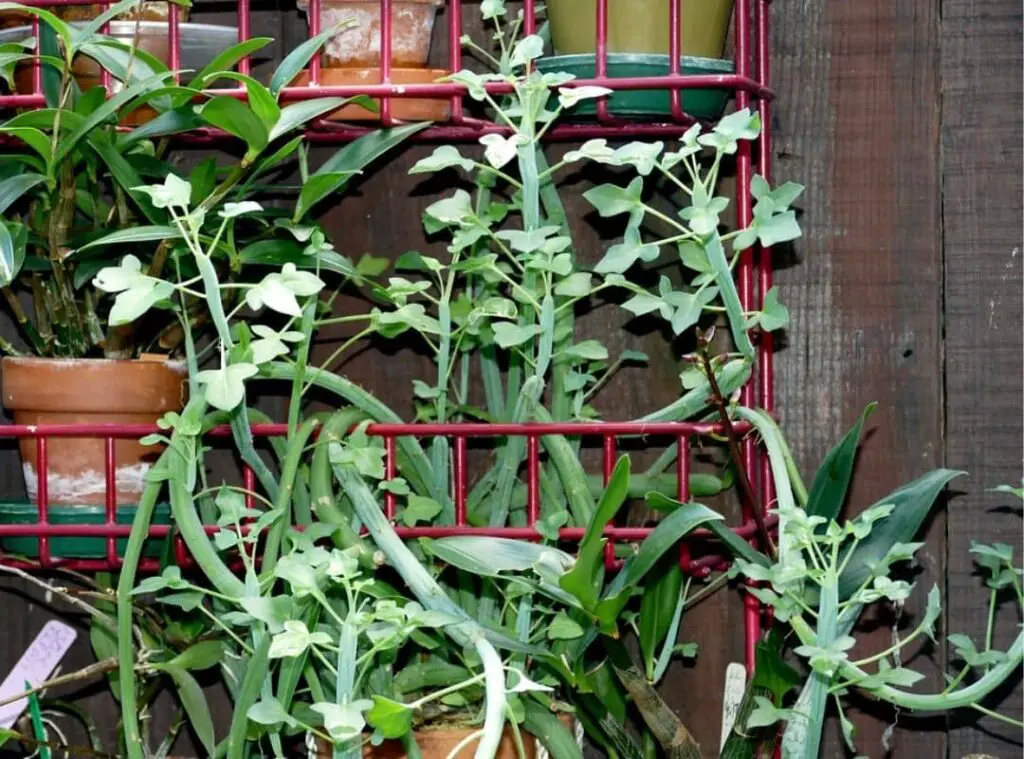Hot dog cactus is commonly known as the candle plant, Sausage plant . It is a famous house plant among the succulent enthusiasts.
They have inherited these common names due to the cylindrical shape they got.
Hot dog cactus is a perennial and evergreen succulent. Further they belong to the Asteraceae family and to genus Senecio. These are endemic plants to South Africa.
Succulents and cactus require easy maintenance from you and Hot dog cactus are no different to them. If you ensure that you provide its necessities, Hot dog cactus will perform well.
So, if these features have already made you excited in learning about them further, this article would be useful for you.

How do I identify hot dog cactus?
As aforesaid, Hot dog cactus have a cylindrical shape in their foliage, and you could easily identify them from that characteristic.
Their foliage color is green. Their blooms would be white would form in small cups, and the flower stalks will arise from the stem edges during the latter part of the year.
You may identify the Hot dog cactus from that feature during winter. However Hot dog cactus blooms are not showy though.
Besides, Hot dog cactus have stems in gray green color. Further they will have dark green markings towards the bottom part of the stem.
Those stems are long and slender. Moreover, they will have jointed segments which make them look like sausages. Their leaves are deep green and those will form over the leaflets.
Size of the plant
Hot dog cactus would rise to a height of one foot while their stems cluster would grow up to about 10 inches in width.
Growth rate
Hot dog cactus usually grows well in winter.
One look care guide
| Botanical Name | Senecio articulatus |
| Common Name | Candle plant Hot dog cactus Sausage plant |
| Plant Type | Cactus |
| Mature Size | 10 inches in width. |
| Sun Exposure | Full Sunlight to semi shade |
| Soil Type | Well draining |
| Soil pH | 6.6-7.5 |
| Bloom Time | Winter |
| Flower Color | White |
| Hardiness Zones | USDA hardiness zones 9b-11b. |
| Native Area | South Africa |
| Toxicity | Toxic |
| Average price | $ 7 |
How do you take care of a hot dog cactus?
Light Requirement
Hot dog cactus have typical requirements in terms of sunlight. Literally they will perform well with full sunlight or with semi shade.
Direct sunlight could be harmful for these plants. Ideally they would prefer to have full sunlight in the morning.They can withstand the semi shade during the harsh afternoon time.
Temperature and humidity
They can withstand a temperature of 25 degrees Fahrenheit ( – 4 degrees Celsius ) during winter.
If you leave them exposed to freezing temperatures for too long, it will result in stunt growth of the plant.
If you live in much colder climate conditions, you could be tactful in placing them outdoors during summer and bringing them indoors during winter and fall.
You need to shift them outdoors only after you ascertain that there will be no frost damage.
Is it cold hardy?
Hot dog cactus is cold hardy up to 25 degrees Fahrenheit ( -4 degrees Celsius). However, if you grow them under colder weather conditions, it will result in stunt growths of the plants.
USDA Hardiness Zone
Hot dog cactus’s preferred hardiness zones are USDA hardiness zones 9b-11b.
Watering Requirement
Hot dog cactus can tolerate hot and dry drought weather. Hence , you should ensure that you do not over water them particularly during summer.
Instead, water them infrequently. Besides, you should ensure that you let the soil wither between two watering sessions.
You should be vigilant to not provide them excess water at any given time as it could be quite harmful for them and result in rotting. It could even be fatal sometimes.

Soil Requirement Type / ph.
The right ph. of the soil mix should be around 6.6-7.5. A well-draining soil mix would help for the Hot dog cactus optimal growth.
It should ideally be a mix of two parts of sand, one part each from loam ,gravel and from peat moss.
Avoid growing the Hot dog cactus in ordinary soil mix as they do not have an excellent drainage like the aforesaid soil mix.
It is crucial that you provide a right soil mix for them to grow well and only then will you benefit from proper watering also.
Pot size Potting and Repotting
Ideal pot type to grow the Hot dog cactus would be either clay pots or terracotta pots .Additionally , it should have sufficient draining holes as well.
Moreover, you can consider repotting them in spring. You do not have to report them on a constant basis though.
Where to Plant
You can plant hot dog cactus as annual plants.
Furthermore , they would grow well in containers as well. In addition to that, grow them in a well-draining soil mix and in a porous pot as well.
Fertilizer and time of year.
In terms of feeding the Hot dog cactus , you can do it during the beginning of the spring. On the other hand, suspend feeding them during the rest of the months.
They require only a minimal fertilizer requirement and if you feed them excessively it will cause the plants to cause feed burns. Best fertilizer to use for these would be a diluted liquid fertilizer.
Dormancy
Hot dog cactus would go dormant during summer.
During summer, suspend feeding them and ensure that you water them infrequently too. In fact their flowering would also take place in winter.
Can be toxic to pets
Hot dog cactus is toxic for pets.
Hence ensure that you do not leave your pets to hang around the plants. Hot dog cactus has toxins which could be poisonous for animals.
Hence do not grow them outdoors, if there are regular animal visitors as they will end up eating them.
Common bugs and illnesses
Too much water could be the culprit of many diseases of the Hot dog cactus.
In addition to that, if you grow them in a poor draining soil mix, it could also create excess moisture levels around the plants and result in root rot. Root rot could be so annoying as it could even kill the Hot dog cactus.
Besides root rot , chances are that you may come across pests’ attacks from spider mites and from whiteflies as well.
Low humidity levels are quite attractive for these pests. You could mainly spot them in winter. To remedy them, you could remove them manually by using the cotton swabs dipped in alcohol.
You can gently wipe them off with that. Alternatively, you could spray some water for the plant too. Besides, you could use either miticide or an insecticide as well.
Special Care tips
As aforesaid, Hot dog cactus need only a minimum supervision from you. However, you should ensure that you water them at moderate levels at the right time.
Additionally, grow them in an appropriate soil mix as well. The exposure for adequate sunlight is also crucial.

How to propagate hot dog cactus
Just as growing Hot dog cactus, propagating them is also very simple. To propagate you may use stem cuttings or division.
If you are doing the stem cutting, first you should cut the stem right beneath the joint segment. Next let those cuttings wither overnight.
That will make the cutting ends hard. After that, dip the cuttings in a rooting hormone and place them in a potting medium which has an excellent draining.
If you want to use the division method for the propagation, you need to first simply remove the plant from its planters during spring and ideally at the beginning of spring.
Take a new pot which is filled with a well-draining soil mix. Once you remove the plant, knock away the older soil around the roots of the Hot dog cactus.
Separate the root ball of the cactus and segregate it into two or three sections while using either a pair of scissors or gardening shears.
Next place each section in sandy soil and add a liquid fertilizer during spring. Limit the feeding frequency only once or twice as it will be enough to stimulate the new growth of the plants.
Hot dog cactus plant benefits.
Hot dog cactus would be quite handy to use for cactus gardens as well as in succulent gardens. Besides, they would be great picks for containers as well.
Conclusion
Before concluding, I hope you were able to learn something new about these beauties and this information made you excited in having them. Happy gardening with Hot dog cactus !
Read Next : Crinkle Leaf (Adromischus Cristatus) | This Succulent Is Not Normal! |
